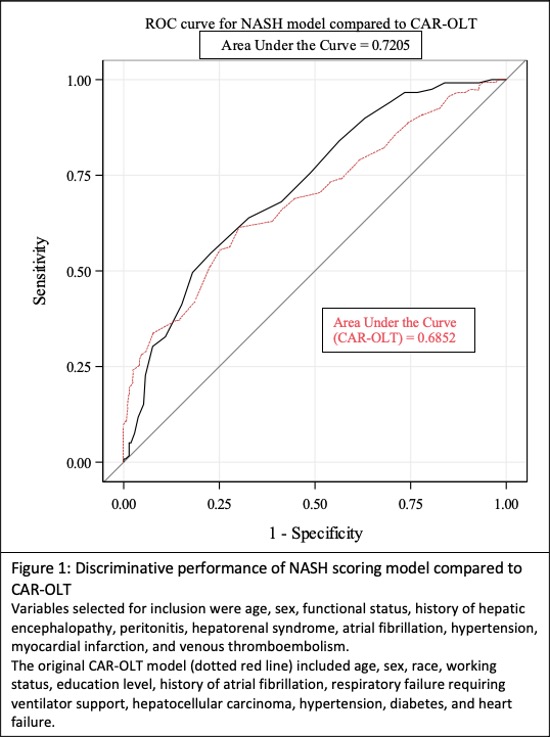Derivation of a Cardiac Risk Index for Use in Liver Transplantation for Non-Alcoholic Steatohepatitis
Northwestern Memorial Hospital, Chicago, IL
Meeting: 2022 American Transplant Congress
Abstract number: 517
Keywords: Heart, Hypertension, Risk factors, Surgery
Topic: Clinical Science » Liver » 51 - Liver: Retransplantation and Other Complications
Session Information
Session Name: Retransplantation and Other Complications
Session Type: Rapid Fire Oral Abstract
Date: Tuesday, June 7, 2022
Session Time: 5:30pm-7:00pm
 Presentation Time: 5:30pm-5:40pm
Presentation Time: 5:30pm-5:40pm
Location: Hynes Room 313
*Purpose: Cardiovascular events (CVEs) are the most common cause of early mortality after liver transplant (LT), and LT candidates with non-alcoholic steatohepatitis (NASH) are at highest risk for CVEs. The Cardiovascular Risk in Orthotopic LT (CAR-OLT) score quantifies risk for post-LT CVEs, but its accuracy in LT candidates with NASH is unknown. We propose a new prediction model for risk of CVEs among NASH LT candidates and compare its performance to the CAR-OLT score.
*Methods: All adults who underwent first LT at a large United States urban transplant center (2/1/2002 – 12/31/2020) were included. Data were drawn from the Organ Procurement and Transplant Network (OPTN) and linked to data from the electronic health record. Primary outcome was 1-year CVE, defined as death from a CV cause or hospitalization for myocardial infarction (MI), cardiac revascularization, heart failure, atrial fibrillation (AF), cardiac arrest, and/or stroke. NASH was identified based on OPTN primary or secondary listing diagnosis for LT or cryptogenic cirrhosis plus metabolic syndrome comorbidity. All pre-LT variables with p ≤ 0.15 on bivariate analysis were considered for model inclusion. Akaike Information Criterion was used for model selection using backward selection. Receiver operating curve analysis was used to compare model discrimination.
*Results: Among 1788 LT recipients, 330 (18.5%) were listed for NASH. Of these, 115 (34.9%) had 1 year CVE. Variables included in the final model were pre-LT recipient age, sex, functional status, hepatic encephalopathy, peritonitis, hepatorenal syndrome, MI, AF, hypertension, and venous thromboembolism. Only age, sex, history of AF and hypertension were shared risk factors within the CAR-OLT score. The discriminative performance of the new point based score (C statistic = 0.72) was superior to the CAR-OLT score (C statistic = 0.69) for 1-year post-LT CVEs in candidates with NASH (Figure 1).
*Conclusions: Patients being considered for LT for NASH cirrhosis have a unique cardiovascular risk profile not captured by existing risk prediction models. This study proposes a novel point based risk prediction tool to guide future cardiac risk stratification in patients with NASH cirrhosis being considered for LT.
To cite this abstract in AMA style:
Levy P, Harrington C, Cabrera E, Gao J, Gregory D, Padilla C, Crespo G, VanWagner L. Derivation of a Cardiac Risk Index for Use in Liver Transplantation for Non-Alcoholic Steatohepatitis [abstract]. Am J Transplant. 2022; 22 (suppl 3). https://atcmeetingabstracts.com/abstract/derivation-of-a-cardiac-risk-index-for-use-in-liver-transplantation-for-non-alcoholic-steatohepatitis/. Accessed December 6, 2025.« Back to 2022 American Transplant Congress

